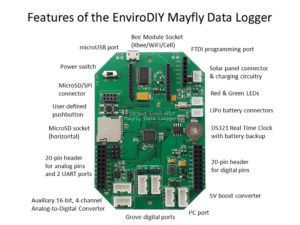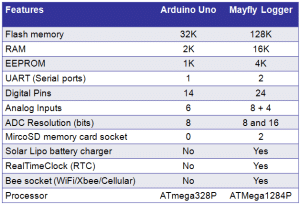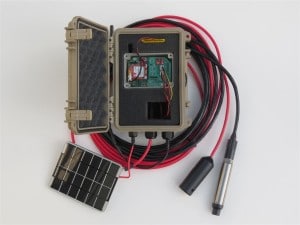We are excited to introduce our new custom Arduino-based datalogger board, the EnviroDIY Mayfly Logger. It has a combination of features and capabilities that make it one of the most powerful and flexible logger platforms available.
It is similar to some of the boards we’ve used in the past, like the Seeeduino Stalker, but we also added a lot of features and functionality to make it even easier to use. The most significant improvement is that the Mayfly uses a more powerful processor – the ATmega1284P, instead of the 328P that is found on the Stalker, Arduino Uno, and most other Arduino boards. This means that the Mayfly has 4 times more flash memory for sketches and 8 times more RAM, 2 serial UART ports, and almost twice as many I/O pins.
The Mayfly also has onboard LiPo battery charging circuitry and a DS3231 RealTimeClock. In addition to the usual 8-bit Analog-to-Digital converter input pins you usually find on Arduino boards, we’ve added an separate higher resolution 16-bit ADC for 4 single-ended measurements or 2 differential channels.
There’s a horizontal MicroSD memory card slot on the board for storing your logged data, and a second optional vertical card slot can be added that makes it much easier to access the memory card when the Mayfly is mounted inside an enclosure. And there’s a Bee socket for mounting any module with the standard Bee footprint, allowing you to add wireless capability like WiFi, Xbee radios, or cellular.
The Mayfly has 6 Grove connectors for easy connections to peripherals. We’ve also built a few different add-on shields that connect to the Mayfly via the two 20-pin headers. The shields can be customized to provide connectors for different types of sensors or other inputs, or for outputs to control equipment or show data on small displays.
A watertight enclosure with clear lid can hold the Mayfly, interface board, battery, telemetry module, and small solar panel for a compact, self-charging logger, or it can be put inside a larger case for more security and durability. The Mayfly is only 3.7″ x 2.5″ (94mm x 64mm), which is about the same size as a RaspberryPi board.
We will be sharing more technical details about the Mayfly very soon, as well as information about when and where you’ll be able to order your own. We’d also like to thank the very supportive people at SODAQ who assisted us in the design of the Mayfly after we had very good success with their SODAQ Mbili boards earlier this year.

 Welcome to EnviroDIY, a community for do-it-yourself environmental science and monitoring. EnviroDIY is part of
Welcome to EnviroDIY, a community for do-it-yourself environmental science and monitoring. EnviroDIY is part of 


This is great news. I have just started an investigation into low cost and/or open source data loggers, partly in anticipation of a rolling program of hydrology data logger replacement and partly to promote / aid in citizen science and crowd sourced environmental data gathering. Very much looking forward to hearing more about this and hopefully getting to experiment a bit with it in 2016.
I agree with the previous post in that this is great news. I hope it is such that newbies can learn and implement in short order. I have long thought a basic logger capable of operating and recording water levels utilizing an ADC and current loop 4-20 mA transducers would be well received. I know I would like to be able to work with something on this line.
Most commercial options are far more complicated than necessary and far too expensive to allow for routine upgrade/replacement.
Nice to see. The adc seems to have a low Vref voltage drift – though needs to be calculated over the temperature of interest. For a 4-20mA need to be able to generate/switch ~15V to supply the sensor.
Should fit nicely with arduino. I’m wondering if there would be any interest in a instrument interface being RS485 with 12V and python for processing the serial stream? Seems like 20mA is a basic standard that is open by its simplicity, but if only there was something that could do the RS485.
I’m not sure if the questions regarding the 4-20mA circuit would be sufficed by something like this?
4-20mA Brick
Very good info on using RS-485 with arduino platforms is located here:
Nick Gammon RS-485
I’ve also been experimenting with the SODAQ Mbili, so really interested in the Mayfly. How can we get hold on one (or more) ?
Hi @Steve Roberts, we hope to have that information available very soon!
Here’s an update for everyone wondering about the board availability. We went through one more round of design updates to add some extra features like an onboard FTDI-USB chip and a 5-volt boost regulator to generate 5v for any sensors or devices you want to power. The final Mayfly production run should be ready for purchase at an online retailer in about a month from now (early March). More updates will follow soon.
Can’t wait….Can you tell us which online retailer ? The 5V boost will be really useful. I’m using several Mbili with power boost to 5V to power long 1-wire sensor bus.
They are being manufactured right now, but we can’t announce availability and online store info until everything is finalized. There was a slight slowdown in the process due to the holiday in China and its effect on the supply chain, but we’re still hoping to have them for sale very shortly.
The boards are now available on Amazon: http://envirodiy.org/mayfly-boards-now-available-on-amazon/
Any update on Mayfly availability? Thanks!
And a second request for update…desperate to get my hands on one (or more)…
We’re still waiting for the first big manufacturing run to get delivered. Once it does, we’ll get it to the distributor as soon as we can. In the meantime, we’ve been working on documentation and instructions, so look for postings that info on this site early next week.
Good news – the boards finally arrived a few days ago, I’m now working on getting everything ready for the online sales, details to follow shortly!